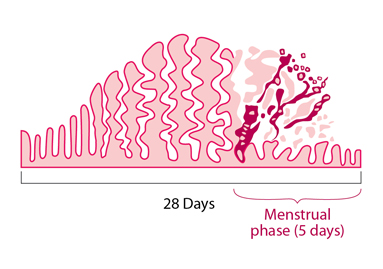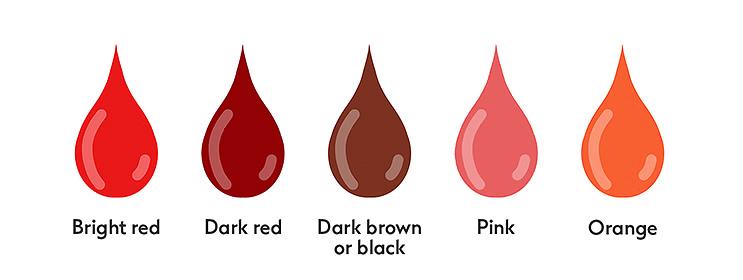
Maintaining general health and reproductive health requires being aware of the warning signals of unhealthy periods. Women’s menstrual cycles differ greatly from one another, yet some symptoms could point to underlying medical conditions. These are a few signs that something is off with your menstrual cycle and that you should see a doctor.
1. Menorrhagia, or excessive menstrual bleeding

Periods so thick that you frequently need to replace your pad or tampon within an hour or two are known as menorrhagia, or severe menstrual flow. This illness can cause serious health issues, such as anemia, so it’s not simply a little discomfort. Fatigue and weakness are symptoms of anemia, a disorder in which the body does not produce enough healthy red blood cells to supply enough oxygen to the tissues.
Menorrhagia can be brought on by uterine fibroids, polyps, hormonal abnormalities, or even some drugs. In addition to heavy bleeding, women who have these symptoms frequently pass huge blood clots, have periods that last longer than seven days, and suffer excruciating menstrual cramps. It is crucial to speak with a healthcare professional if you think you may have menorrhagia in order to ascertain the cause and the best course of action.
2. Non-Regular Times

Another indication that anything may be amiss with your menstrual health is irregular periods. The average menstrual cycle lasts anything from 21 to 35 days. An underlying health problem may be indicated if your cycles are regularly shorter than 21 days or longer than 35 days, or if you skip periods or go several months without getting your period.
Period irregularities can be caused by a number of conditions, including hormone imbalances, thyroid issues, and Polycystic Ovary Syndrome (PCOS). PCOS is a common condition that impairs the function of a woman’s ovaries and can cause irregular, extended, or infrequent menstrual cycles. Any type of thyroid condition, including hyperthyroidism or hypothyroidism, can interfere with your menstrual cycle. It’s critical to monitor your menstrual cycle and talk to your healthcare practitioner about any abnormalities because these conditions can be effectively managed with early diagnosis and treatment.
3. Severe Dysmenorrhea, or Menstrual Cramps

Period cramps that interfere with your regular activities are not normal; however, some cramping is usual throughout your period. Dysmenorrhea, another name for severe menstrual cramps, can be extremely incapacitating and frequently indicate an underlying medical issue such endometriosis or fibroids.
When tissue that resembles the lining of your uterus grows outside of it, it is called endometriosis and can cause excruciating pain, particularly during menstruation. Noncancerous growths in the uterus called uterine fibroids can result in severe cramps and bleeding. For an accurate diagnosis and course of therapy, both disorders necessitate medical attention. It’s time to visit a doctor if over-the-counter painkillers aren’t relieving your period cramps.
4. Atypical Color or Uniformity

Menstrual blood’s color and consistency might reveal a lot about a person’s health. Normally, a healthy monthly flow is dark red, but noticeable clots or menstrual blood that is persistently bright red, brown, or even orange may indicate a problem.
Vibrant crimson blood may be a sign of fibroids or polyps, or it may suggest a high flow. Usually brown blood is old blood coming out of the uterus, but if it smells different, there may be an infection. Cervical fluid and orange blood can occasionally combine, and if the blood has an unpleasant stench or a gray tint, it might be a sign of a bacterial infection or STI. Larger-than-a-quarter blood clots may also indicate fibroids or other problems. It’s crucial to consult a doctor if you observe any noticeable changes in the color or substance of your menstrual blood.
5. Identifying Intervals

Between-period spotting or bleeding can be concerning and shouldn’t be disregarded. Persistent spotting may be a sign of more serious problems, including uterine polyps, fibroids, or even cervical cancer, even though it can also be a side effect of hormonal contraception.
Growths called uterine polyps, which are affixed to the uterine wall, might result in irregular menstrual bleeding. Though less often, bleeding between periods can also be a symptom of cervical cancer. Mid-cycle spotting can also result from thyroid problems and hormonal imbalances. It is important to speak with your healthcare physician if you have unexplained spotting in order to identify the source and the best course of action.
6. Menorrhea, or Absent Periods

Amenorrhea is the term used to describe the prolonged (three months or longer) absence of menstruation in women of reproductive age who are not menopausal, pregnant, or nursing. This condition may be a sign of serious health problems such thyroid abnormalities, intense activity, or drastic weight reduction.
PCOS can also induce amenorrhea by interfering with regular ovulation. Premature ovarian insufficiency (POI), in which the ovaries cease to function normally before the age of forty, is another possible cause. Significant weight fluctuations and high levels of stress might also interfere with your menstrual cycle. It’s crucial to visit a healthcare professional if you’ve missed several periods in order to determine the underlying cause and obtain the necessary treatment.
7. Excessive Weakness or Fatigue During Times

Experiencing unusual fatigue or weakness during your menstrual cycle may indicate iron deficiency anemia. Significant blood loss from heavy monthly flow might deplete your body’s iron reserves and result in tiredness and exhaustion. Hemoglobin, a protein found in red blood cells that transports oxygen throughout the body, is made possible only by iron.
It’s crucial to get medical help if you discover that your exhaustion is severe enough to affect your everyday activities. If necessary, your healthcare professional can suggest iron supplements or dietary adjustments based on the results of a blood test to determine your iron levels.
8. Prolonged Times (Polymenorrhea)

Extended bleeding, or polymenorrhea, is the term used to describe periods that repeatedly last longer than seven days. Hormonal abnormalities, uterine fibroids, polyps, and blood coagulation issues can all contribute to prolonged periods.
PCOS and thyroid problems are two illnesses that can cause hormonal abnormalities. Prolonged bleeding can also be caused by uterine fibroids and polyps. Even though they are less prevalent, blood coagulation issues can cause heavy menstrual flow and prolonged periods. It’s critical to speak with a healthcare professional if you have prolonged symptoms in order to identify the source and the best course of action.
9.Knowing When to Get Medical Help

If you are experiencing any of these symptoms, you should speak with a medical practitioner. Maintaining reproductive health and treating possible problems require early detection and treatment. The following broad recommendations will help you decide when to get medical help:
- Heavy Menstrual Bleeding: Seek medical attention if you are passing large clots or if you need to replace your pad or tampon more frequently than once per hour or two.
- Irregular Periods: See a doctor if you frequently miss periods or if your menstrual cycle is longer than 35 days or shorter than 21 days.
- Severe Menstrual Cramps: Consult a doctor if your cramps are so bad that they prevent you from going about your everyday business and over-the-counter painkillers don’t help.
- Unusual Color or Consistency: Seek medical attention if you see any notable variations in the color or consistency of your menstrual blood, such as a persistent bright red, brown, or orange stain.
- Spotting Between Periods: See a doctor if you suffer from bleeding or spotting that isn’t related to your period.
- Absent Periods: Consult a physician if you are not menopausal, pregnant, or nursing and have missed many periods.
- Extreme Fatigue or Weakness: Consult a doctor if you have extraordinary levels of fatigue or weakness throughout your menstrual cycle, especially if it interferes with your regular activities.
- Extended Periods: See a doctor if your menstrual cycle continuously lasts longer than seven days.
10.Monitoring Your Menstrual Cycle

One very useful technique for spotting patterns and variations in your monthly cycle is keeping a period journal. Make a note of your period start and finish dates, the intensity of your flow, any odd symptoms, and your overall physical and mental well-being. Your healthcare professional can better accurately diagnose and manage any menstrual health issues with the use of this information.
Numerous smartphone apps are also available to assist you in monitoring your menstrual cycle and symptoms. These applications can give you information on the health of your menstrual cycle and notify you of any irregularities that might need to be seen by a doctor.
Summary
Maintaining your general health and well-being can be facilitated by being aware of the warning signals of unhealthy times and by getting medical assistance when needed. There are a number of signs that something may be wrong with your menstrual health, including heavy bleeding, irregular periods, severe cramps, odd blood color or consistency, spotting between periods, absent periods, significant exhaustion, and prolonged periods. You can make sure that any possible problems are dealt with quickly and effectively by monitoring your menstrual cycle and seeking medical advice as needed.